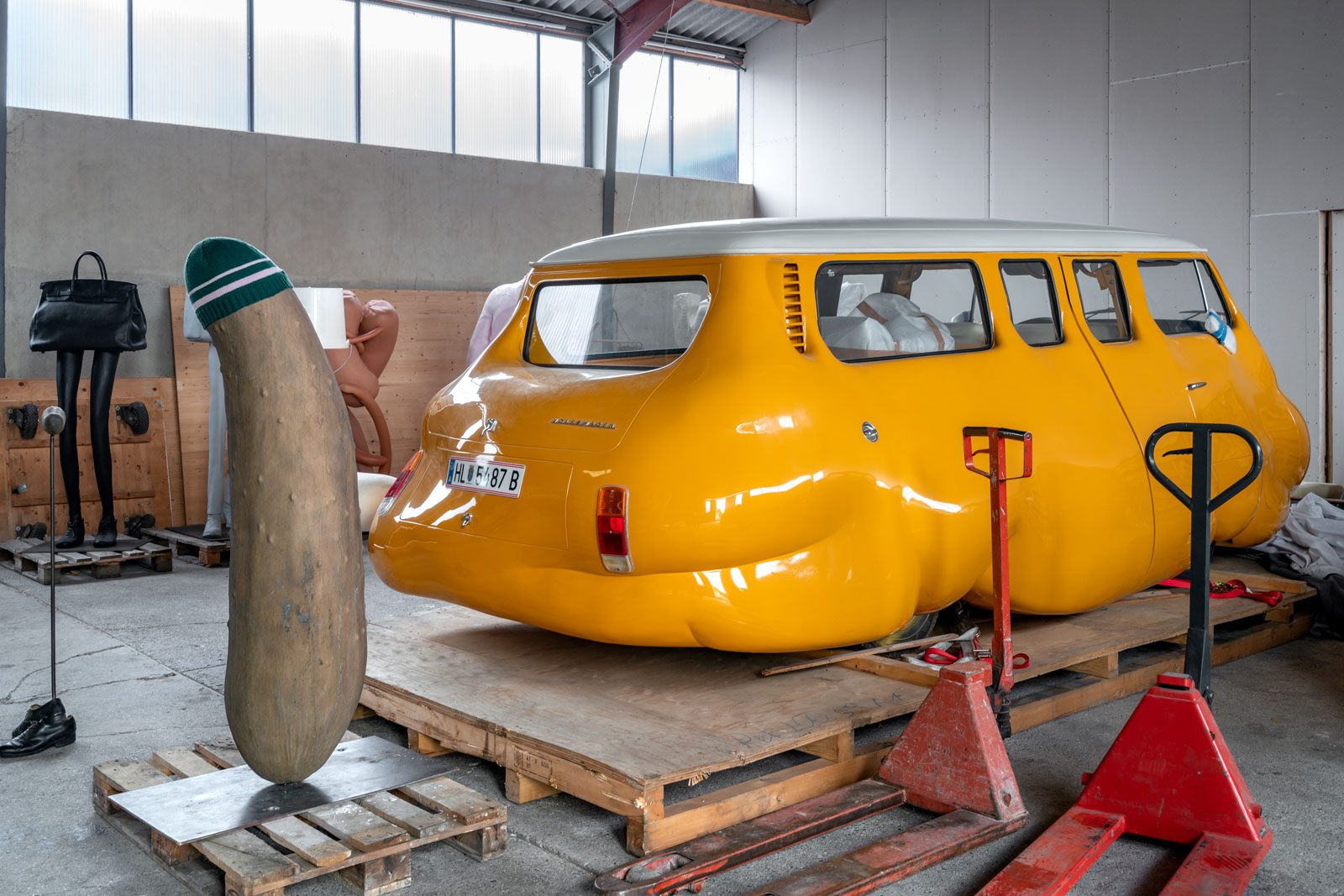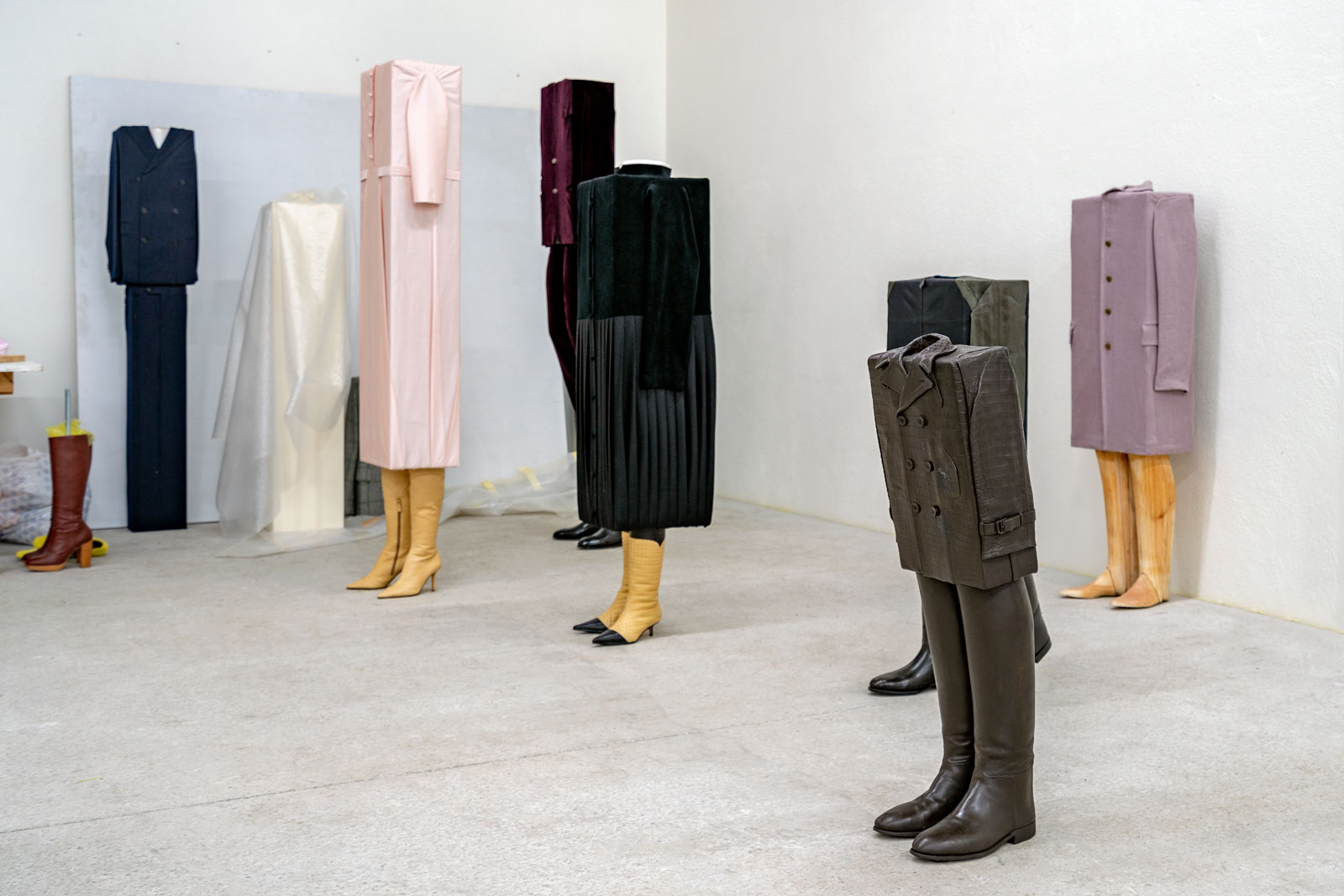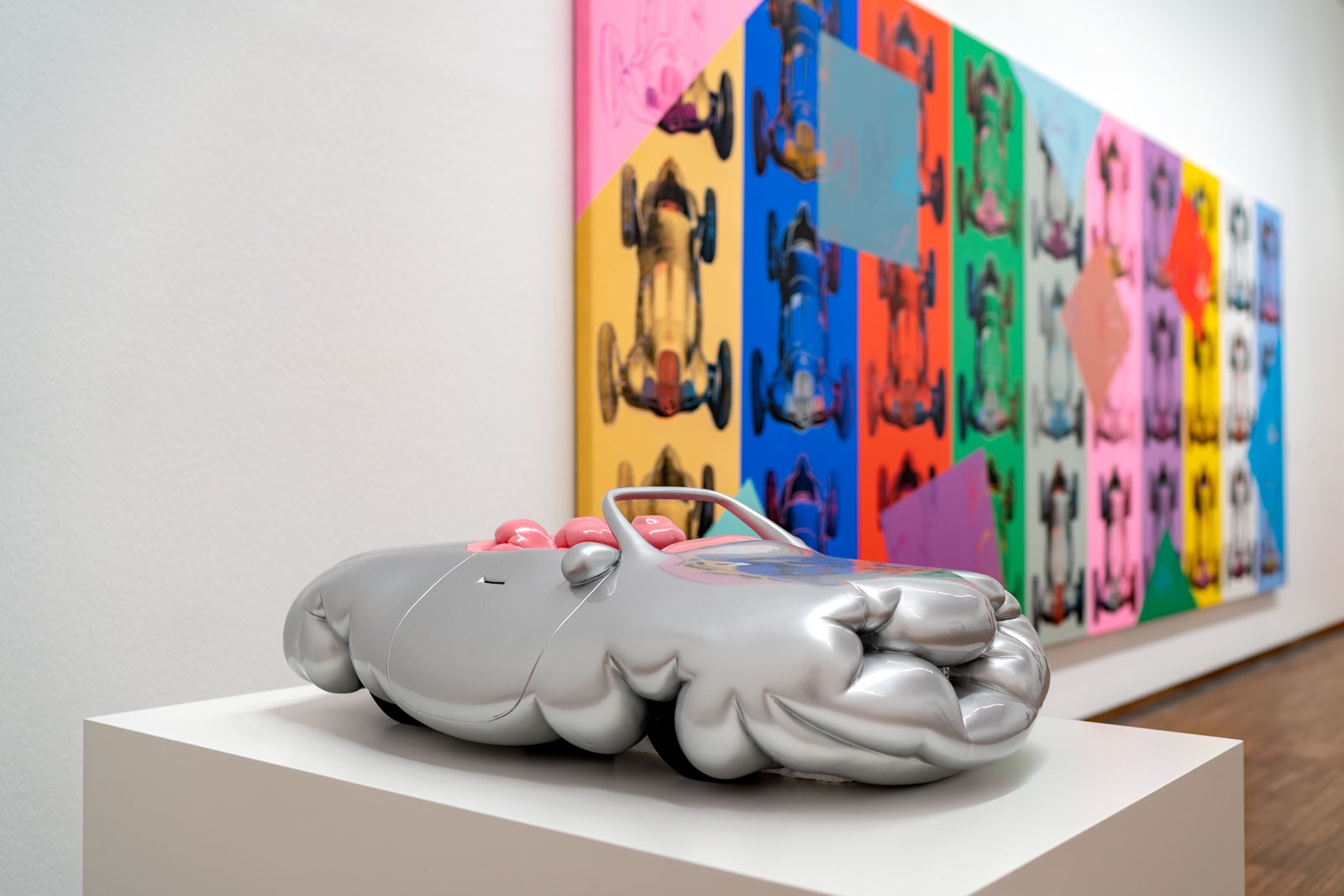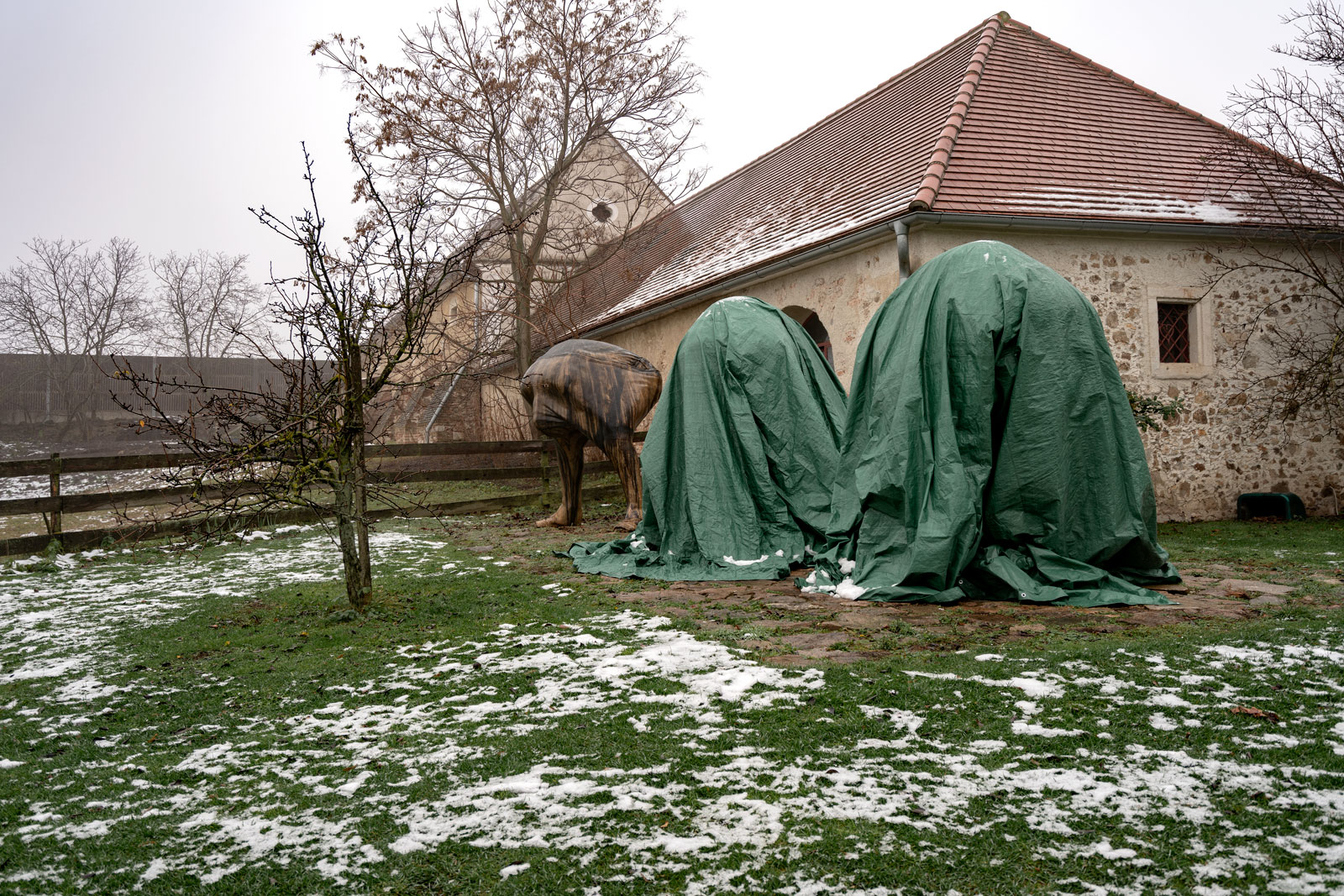Currently covered by the sleeve of his winter jacket, the tattoo on Erwin Wurm’s arm, “One minute forever,” evokes the series of action-based performative sculptures he conceived 21 years ago. For a One Minute Sculpture Wurm offers a handwritten instruction and/or a suggestive drawing for the audience to follow. For example, a drawing that shows a person sitting on the floor with his legs stretched out accompanies Hold your breath and think of Spinoza. “I was never democratic in the way artists invite people to decide. They have to follow my instructions. They can do different things with the one-minute sculptures, but then it’s not a piece of mine. It doesn’t matter. It’s also ok.” Apparently so, as some of his one-minute sculptures inspired Claudia Schiffer, for a shoot in Vogue Deutschland, and the band Red Hot Chili Peppers, who acted them out in their 2003 music video “Can’t Stop.”
Wurm conceived One Minute Sculptures contemplating Michelangelo’s idea that a sculpture should be able to roll down a mountain and still exist for 500 years. “Today nothing exists long. We don’t repair things anymore. We throw them away.” So, he realized the contemporary counterpart to Michelangelo’s concept would be to create an art piece that existed for a short period of time only. By photographing his One Minute Sculptures, Wurm could show them to the world. “How was I, as a young artist, supposed to ship my heavy sculptures to other countries? I needed something lightweight. That’s how I came up with the idea of taking photographs. The sculptures could disappear, but I could always re-perform them or re-invent them at a later date.” His first series of photographs, now in the collections of the Tate Modern and the Pompidou, were produced for a show in Bremen in 1997. “I was there ten days in advance and I didn’t bring anything. They were all quite nervous. I asked them if I could use the materials lying around and the people working there, if they would volunteer, for pictures.”


A film still from the series shows the director of the Künstlerhaus art gallery transformed into a living sculpture, with pens in his nose and ears and film canisters in his eyes. Wurm insists that everyone has put a pen or pencil in a nostril at least once. “Or, everybody knows the taste of a pencil. I know the taste exactly!” Because his intention is to shed light on the absurdity of our world, such a point becomes interesting to him. “It creates embarrassment; it creates ridiculousness,” he says. Although his instructions play with the feeling of inappropriateness, he is bound by certain moral and aesthetic constraints. “I never show naked people. I am not dealing with racial, sexual or political questions. I want to keep this out. And I always use people roughly the same age as me. I find it intensely vulgar as an older man to picture young women. The focus is totally wrong for the thing you want to speak about.”
The One Minute Sculpture series has been branching out lately in different directions – to Word Sculptures and Drinking Sculptures. Wurm opens a book filled with handwritten sentences and reads two aloud, “Pencil stuck in an ear the tip facing outward” and “Block of smell follows a person through the room.” He explains the second one. “You can define the smell as a sculptural or physical block. Also thoughts! Our brain is a fantastic tool to create a 3d sculpture without a physical presence of the sculpture.”
Stimulating the viewer’s imagination is central to Wurm’s work and has been since the very beginning, when he presented his Dust Sculptures. “I put an object in the middle of a pedestal, spread dust over it and took the object away. Then you saw the imprint of the object missing. I love the ephemeral and the non-existent, because we are totally controlled by things and define ourselves through owning things.”
I love the ephemeral and the non-existent, because we are totally controlled by things and define ourselves through owning things.
Erwin WurmThe Drinking Sculptures are not so non-existent as they are made with old furniture and invite the audience to open cabinets, take a glass, pour some liquor, and drink. Because he was too weak (“Thank God”) to be a heavy drinker, Wurm no longer drinks, but he wants to understand why Martin Kippenberger, Edvard Munch, and many others were heavy drinkers; why he is still alive while many others are not. “When you are in the studio alone and you have these thoughts, it is difficult not to fall into a depression. So people just to get out of this, they start to drink. Mankind was always related to the excess . . . It’s like a door into this strange world.” When people drink at his sculptures, they will be “part of the excess.”
In Wurm’s surreal world, houses and cars face obesity issues and people with boxlike bodies are headless. The Fat House stands proudly in his garden estate in Limberg after being a year in Brazil. “I am not giving it away again, because it is such a nightmare to ship it. It’s like a 3d puzzle. It has eighteen parts that get separated and then we mount it together. The problem is that these stripes do not belong to it. We haven’t finished the mounting, because we haven’t had the time.” Further away, overlooking a hill are two examples from his series Melting Houses illustrating the same ideas about property and how we represent ourselves.




In the studio, the Hot Dog Bus, a remodeled mustard color Volkswagen T2b Microbus, is being repaired. Once displayed in Brooklyn Bridge Park for the Public Art Fund, “it gave away 50,000 free hot dogs.” Now it has been sold to a private museum in China. Discussing its cuddly shape, Wurm explains that he turned at first to computer technology. His gallery at that time had connections to a General Motors/Opel factory in Rüsselsheim, so he tried to work with their engineers who were using advanced 3d modelling. “I went there for 3 days. It was terribly expensive, but it did not work. Then I thought that if we cannot work with this, we have to go back to what real sculptors are doing. So we modelled a real car over by adding layers of styrofoam, polyurethane and shaped the form.”

Apart from the pickle, there is another “important European icon, food icon” that often shows up in Wurm’s work, the sausage. By magnifying it, he gives it an abstract quality. He even adds thin long limbs to it to make it anthropomorphic and give it a sort of personality. Some of them look like they are dancing, others are embracing, and others are raising their fists in the air. “Das ist mir Wurscht means I don’t care – it’s a sausage to me, or by calling someone a sausage, you mean he is stupid.”

His Box People (“that’s how I call them”) stand in formation like proud little soldiers in his studio. All the figures are headless. “Who needs a head anyway!” When these made an absolute sensation, a similar look cropped up in a runway show in Paris. “This was a real robbery. But I don’t want to be the knight of the lost treasure. I don’t want to spend my time suing people. I just went out and showed that it’s my work.”
Wurm is now working on a new series of sculptures for a show in early 2019 at the Thaddaeus Ropac Gallery in London. “This is my research on the body. It’s all body parts, hands, nipple, man’s navel, fingers, on an abstract form. Fat Car is a deformation and I tried to do the same with human beings.”
Wurm is also passionate about painting. In fact, when he first applied to art school, he intended to study painting, but was admitted in sculpture. “In the mid 70s whenever I saw sculptures standing in the park, they were black and horrible and covered in pigeon shit. I was really not interested in that. Slowly I discovered what sculpture can be.” Currently, the Albertina museum in Vienna has dedicated a show to his more than three hundred sketches mostly self-portraits and a few sculptures. The title of the exhibition, Peace and Plenty, is borrowed from a hotel in the Bahamas where Wurm stayed over last Christmas and worked on two new series, Smoking Drawings and Gun Drawings. “I got terrible asthma there. And I could hardly breathe. I had constantly these sprays. So, I woke up in the morning and I started making these smoking series. When you smoke a lot, you have the same thing: lack of oxygen. This was my way of dealing with it.” Wurm sees guns as related because “they also produce smoke.” But he sees more than smoking guns. He feels that many men in Austria and around the world become desperate, go wild, and kill because of anger that is a product of fear, a fear of helplessness. “If you are helpless, you explode somewhere. Men are strange weak creatures. Guns are a part of this.”


Guarding the entrance to the drawings is Wurm’s bloated depiction of German philosopher Theodor W. Adorno, Adorno as Oliver Hardy in The Bohemian Girl (1936) and The Burden of Desperation. In the movie The Bohemian Girl skinny Stan and fat Oliver are in a torture chamber. One of them is squeezed short and the other stretched tall. While Adorno saw art as something very serious, almost sacred, and did not consider humor to be a part of it, Wurm believes that a certain measure of humor and cynicism is necessary to deal with serious issues. “Adorno said after the Holocaust nobody can write a poem anymore, and that’s total bullshit to my understanding especially after such a gigantic drama. Poetry and art are healing the universe.”
While the allusion to Laurel and Hardy seems to make the image of Adorno comic, the sculpture has a serial aspect as well in that Adorno wears a stretched shirt and pants reminiscent of Sweaters Over My Head and 59 Positions. In this series, Wurm uses clothes for sculptural detail. He pulls sweaters over his head and then contorts himself or others into absurd positions. “Jeans and sweaters as a second skin. The jumper as sculpture and the body as material. I am interested in this idea of skin as a boundary.” In his garden there is one such sculpture from the series next to two other sculptures covered with green fabric not to protect them from the weather. “No, it’s because I am unhappy with those and I have to change things. We didn’t want to show you,” he admits openly.
Limberg, 2018. All photographs and text © 2018 Alexia Antsakli Vardinoyanni – www.artflyer.net








